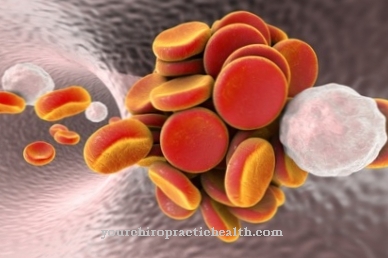The medicinal substance Cabazitaxel Half of it is obtained synthetically and is one of the so-called cytostatics. As such, cabazitaxel is used in the treatment of advanced prostate cancer. One indication is primarily for forms of cancer that cannot be cured by castration. Cabazitaxel achieves its effectiveness by inhibiting the cell division phase of cancer cells.
What is Cabazitaxel?
Cabazitaxel is an important cytostatic drug. This term encompasses various substances that can be used as part of a comprehensive chemotherapy treatment for various forms of cancer.
Cabazitaxel is used in various forms of prostate cancer. The active ingredient is mainly used as a second-line drug. This meant that cabazitaxel is primarily used as an additional line of therapy alongside other drugs. The substance is obtained semi-synthetically and is described in chemistry and pharmacology by the sum formula C 45 - H 57 - N - O 14, which corresponds to a moral mass of approx. 853.93 g / mol.
Cabazitaxel is a white solid at room temperature and may be used. a. used in the preparation Jevtana®. It is approved for the European Union (EU). However, Cabazitaxel is subject to prescription and pharmacy requirements in every member state. Since it is chemotherapy, it is administered exclusively as an infusion solution under medical supervision. Independent ingestion by the patient is thus excluded.
Pharmacological effect on the body and organs
Cabazitaxel is produced semi-synthetically from the natural substance 10-deacetylbaccatin III. This is obtained by extraction from yew needles.
Cabazitaxel achieves its effectiveness by inhibiting the cell division phase. This makes it impossible for cancer cells to develop spindle apparatus. The effects of cabazitaxel are therefore considered to be cytotoxic.
Due to the way the mechanism of action works, cabazitaxel can also be called a mitosis inhibitor.
Medical application & use for treatment & prevention
Cabazitaxel, together with the active ingredients prednisolone or prednisone, is indicated for the treatment of adults with hormone-refractory metastatic carcinoma of the prostate who have already been treated with a docetaxel-based therapy concept.
Accordingly, the most important area of application for cabazitaxel is the treatment of castration-resistant prostate cancer that has already been treated with chemotherapy in advance. Consequently, Cabazitaxel is a second-line drug. It thus only forms the second mainstay in addition to therapy with other active ingredients (so-called second-line therapy).
Cabazitaxel is sold exclusively as a concentrate together with an appropriate solvent. Medical professionals use the concentrate and solvent to make an infusion solution. This clear, yellow or brownish-yellow infusion solution is described as oily and administered intravenously to the patient. This procedure is typical for chemotherapy, as it ensures that it can be taken under supervision by qualified personnel. Independent ingestion by the patient (e.g. orally in the form of film-coated tablets) does not take place.
The award takes place every three weeks. The respective dosage is set at 25 mg / m2 BSA. The duration of the infusion is usually one hour, with this, in addition to cabazitaxel, often other active ingredients such as prednisone or prednisolone are administered. The prerequisite for the use of Cabazitaxel is that the patient has at least 1500 neutrophils per cubic millimeter in the blood.
You can find your medication here
➔ Medicines for bladder and urinary tract healthRisks & side effects
Cabazitaxel can - like all other cytostatics used to treat cancer - lead to side effects that are sometimes severe. These include u. a. a longer lasting, d. H. Neutropenia, febrile neutropenia, or severe diarrhea (diarrhea) lasting more than a week. Any diarrhea that occurs can be countered with electrolyte and fluid substitution, but the treatment should be temporarily suspended and the dose then reduced.
Other side effects of Cabazitaxel include fever, general weakness, general malaise, severe and persistent fatigue, back pain and abdominal pain.
Since cabazitaxel is primarily metabolized by the liver, there is a contraindication for patients with severe liver damage. You should not take cabazitaxel. People with mild or moderate liver dysfunction should tell their doctor. The dosage should be reduced accordingly or another active ingredient should be used.
Cabazitaxel can interact with other drugs. This can be especially the case when taking CYP3A inhibitors such as ketoconazole, OATP1B1 or CYP3A inducers such as rifampicin.
Symptoms of tiredness may occur after taking Cabazitaxel. Heavy machines must therefore not be operated. Participation in road traffic is also restricted. In addition, Cabazitaxel must not be administered if an intolerance is known.













.jpg)

.jpg)
.jpg)











.jpg)